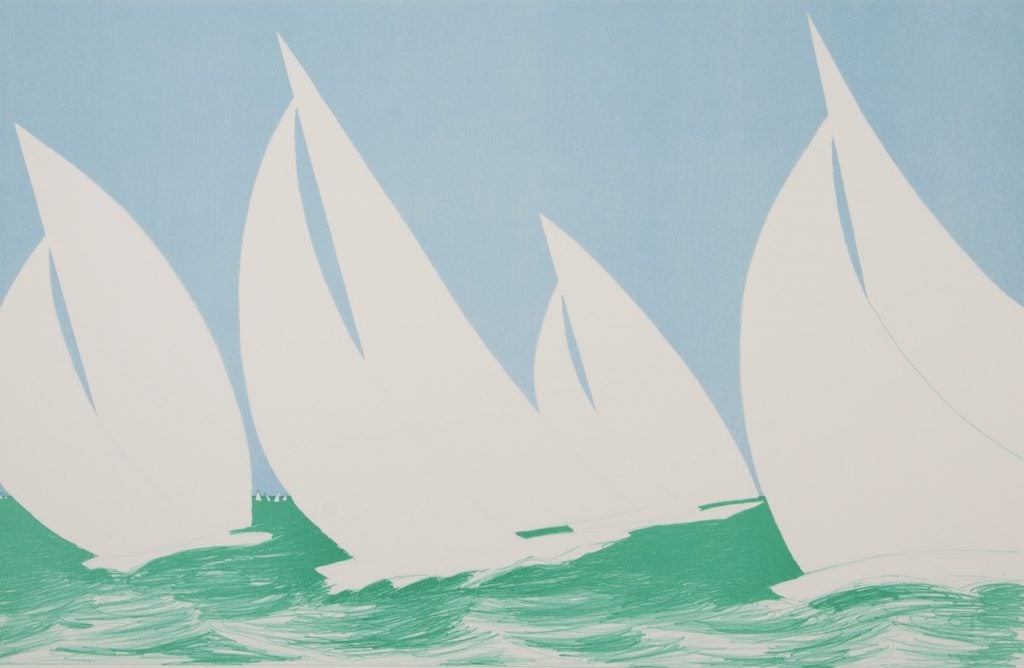Former Curator of University of Michigan’s Museum of Art, Pam Reister, writes on the Cuban artist Emilio Sánchez, who is the cover artist of Michigan Quarterly Review’s current Summer 2019 issue.
Emilio Sánchez was born into one of Cuba’s most prominent families. He lived in privilege on his grandfather’s plantation in Camaguey until he was a teenager, when he was sent to several prestigious boarding schools in Miami and Connecticut, ultimately settling in New York. From a young age, Sánchez was quite cosmopolitan and established the habit of traveling, which he enjoyed for the rest of his life. When his mother and father separated, she remarried and moved to Mexico, and Emilio often visited her there. He was never politically involved in Cuba, and after the revolution he never returned. In the end, Sánchez thought of himself as a New Yorker from Canaguey.
Sánchez discovered art when he was young and received encouragement to pursue it from his family. He spent a year at Yale and two years at the University of Virginia. When he settled in New York he took classes at the Art Students League. The influence of his teachers at the Art Students League, particularly Reginald Marsh, can be seen in his early depictions of people captured in everyday situations and unobserved moments. His signature style, however, moved in a different direction, namely towards architecture and the details of the built environment. Working from sketches and drawings of Cuban Colonial Victorian, modest domestic, and monumental urban architecture, Sánchez focused in on details such as diagonal shadows within a room, open doors, windows and awnings, distilling such motifs to their barest essentials. His bold, clean, colorful images seem boiled down to their elemental geometric forms, with all extraneous details eliminated. Although Sánchez came of age as a painter in the 1950s, the heyday of Abstract Expressionism, he worked in an independent and unique mode virtually devoid of the expressionist idiom of the day. His quiet, spare, oversized details of urban and rural architecture have more in common with close-up details created by Georgia O’Keeffe and Charles Sheeler than the expressive, action painters in New York.
Sánchez documented his neighborhoods and his travels, walking around with a sketchbook and camera making drawings and photographs wherever he went. He seemed to have lived the life of an observer, however, and his art reveals little of his inner self. His finished works were created somewhat intuitively after the fact, without an interest in creating an exact likeness. They clearly represent buildings but seem to “disregard the laws of physics in respect to such paltry affairs as reflection, refraction, and perspective”(Sindelir, 49). He reveled in patterns and captured the repetition of architectural details, turning these details into rhythmic sequences and intensifying them with pronounced contrasts of dark and light as seen in Una Casita Amarilla. The brilliant light, dramatic shadows, and bold colors in his corpus, were inspired by his native Caribbean environment.

Una Casita Amarilla (Yellow House), 1998
color lithograph on paper
UMMA, Gift of the Emilio Sanchez Foundation, 2011/2.123 [© Emilio Sanchez Foundation]
For much of his career Emilio explored the urban scene, buildings seen on his travels, and still lifes. Near the end of his life he was nearly blind in one eye, which may have driven him to repeat certain motifs and series, notably those with strong compositional elements. Examples of these motifs are sailboats, such as La Regata, and clotheslines, such as Tendederos (this subject was sometimes titled Ropa Vieja, or old clothes). Looking at the entirety of his career, clotheslines and sailboats seem like an anomaly, but they have strong formal similarity to the details of building Sánchez created throughout his life. Comparing the awnings of Una Casita Amarilla to the sails or laundry on a line, it is clear that they all do similar work. Although the awnings are not in motion as are the sails and clothes caught in the breeze, they all create patterns of diagonal movement on a flattened ground. The forms are simplified and the bold palette is limited, but the rhythm across the surface is pronounced and dynamic.

color lithograph on paper
Gift of the Emilio Sanchez Foundation, 2011/2.125 [© Emilio Sanchez Foundation]
In 2011, the University of Michigan Museum of Art and several academic museums in the US benefited from the generosity of the Emilio Sánchez Foundation. UMMA received eighty paintings and lithographs from the Foundation when it donated much of Sanchez’s oeuvre to museums across the country. Erik Stapper, UMLaw ‘60, was the Preliminary Executor of the foundation and noted that Sánchez’s will created the foundation tasked with assisting ophthalmologic research and providing art scholarships from the proceeds of the sales of his work.
Works Cited:
Damian, Carol, “Emilio Sanchez, The Last Decade,” Emilio Sanchez: Paintings, Watercolors, Drawings, Prints, The Estate of Emilio Sanchez, 2001.
Sindelir, Robert J., “Emilio Sanchez, A Sense of Place,” Emilio Sanchez: Paintings, Watercolors, Drawings, Prints, The Estate of Emilio Sanchez, 2001.
Featured Image:
La Regata, 1981
color lithograph on paper
UMMA, Gift of the Emilio Sanchez Foundation, 2011/2.71







